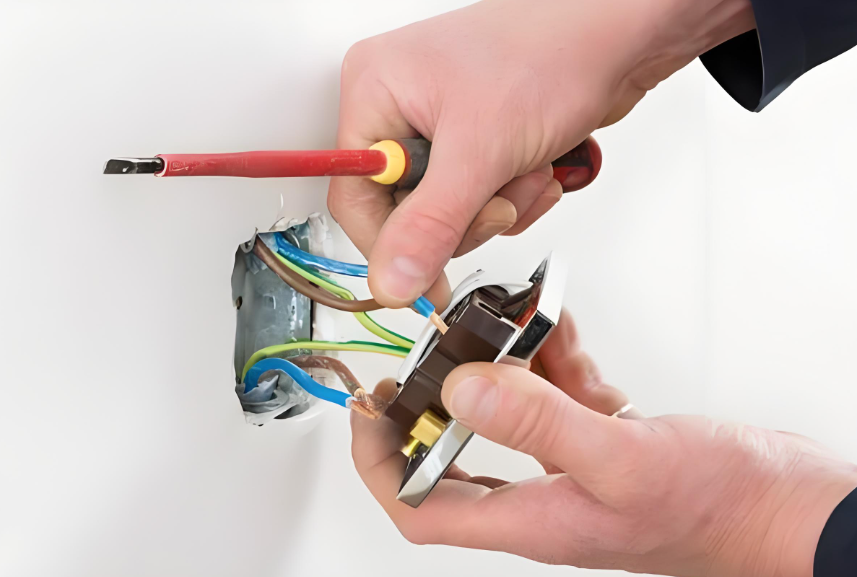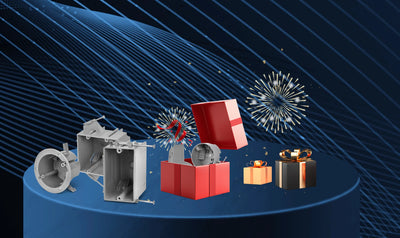Table of Contents
1.The Hidden Risks of DIY Junction Boxes in Industrial Settings
2.5 Safe DIY Scenarios for Factories (With Step-by-Step Guidance)
3.3 High-Risk Cases That Require a Licensed Electrician
4.Cost Analysis: DIY vs. Professional Installation for Industrial 5.Applications
6.2024 NEC Code Violations Factories Must Avoid
7.6 Warning Signs Your Junction Box Needs Immediate Professional Help
8.FAQs: Industrial Junction Box Installation
9.Conclusion: Making the Right Choice for Your Facility

1. The Hidden Risks of DIY Junction Boxes in Industrial Settings
In industrial environments, junction boxes play a crucial role in safely housing electrical connections and circuits. While DIY installations may seem like a cost-effective solution, they come with significant risks. Poor installation practices, such as improper grounding, incorrect wire connections, or using substandard materials, can lead to equipment malfunctions, electrical fires, and hazardous conditions for workers. The complexity of factory electrical systems means that even a small mistake can have severe consequences.
 Catastrophic Equipment Failure: Arcing from loose connections inside a junction box can result in short circuits that harm costly equipment.
Catastrophic Equipment Failure: Arcing from loose connections inside a junction box can result in short circuits that harm costly equipment.
Increased Fire Risk: OSHA reports that bad wire connections are the cause of 68% of electrical fires in industrial establishments.
Regulatory Penalties: Failure to comply with NEC 2024 rules may result in fines of up to $5,000 and, in extreme cases, shutdowns until the infractions are fixed.
Insurance Problems: If electrical work is done without the required license, many insurers will reject claims.

Togalonn’s Solution: Our metal junction boxes reduce DIY errors:
✔ Pre-installed cable glands for secure wire entry
✔ Corrosion-resistant powder coating for harsh environments
✔ Reinforced mounting brackets to withstand vibrations
Pro Tip: Always perform a lockout/tagout (LOTO) procedure before working on electrical systems in factories.
2. 5 Safe DIY Scenarios for Factories (With Step-by-Step Guidance)
While DIY installations can be risky in industrial settings, certain scenarios might be safer for factory owners who are equipped with basic electrical knowledge and the right tools. Here are five scenarios where DIY installation can be safe, along with some practical tips for using Togalonn products:
1.Upgrading Low-Voltage Systems
If you're dealing with low-voltage systems (such as low-power lighting or sensors), DIY can be manageable with proper precautions.
Togalonn Tip: Ensure you select junction boxes with the right capacity for low-voltage circuits, like our Togalonn Low-Voltage Junction Box, designed to handle lower power needs efficiently.
2.Simple Circuit Additions
If you're adding a single additional circuit to an existing setup, it may be safe to DIY as long as the current electrical infrastructure can handle the new load.
Togalonn Tip: Use Togalonn’s Modular Junction Boxes, which provide easy access for additional circuits without compromising on safety.
3.Replacing Outdated Junction Boxes
When upgrading to newer, more efficient models, replacing an existing junction box can be a relatively straightforward task.
Togalonn Tip: Our Togalonn Industrial Junction Box Series are built for durability and compliance with current standards, making replacements easier and safer.

4.Routine Maintenance
For simple tasks such as tightening connections or cleaning the box, DIY can be safe as long as the power is completely turned off and no new wiring is involved.
Togalonn Tip: Always use Togalonn’s Waterproof Junction Boxes when maintaining equipment in areas prone to moisture.
5.Installing Small, Isolated Electrical Components
In isolated areas with minimal electrical complexity, DIY can work if the installation is simple and the risks are well-managed.
Togalonn Tip: For small-scale installations, consider using Togalonn’s Compact Junction Boxes, which are easy to install and designed for simpler setups.
3. 3 High-Risk Cases That Require a Licensed Electrician

Certain electrical situations in industrial settings carry higher risks and demand the expertise of a licensed electrician. Here are three high-risk cases that should always involve a professional:
High Voltage Systems
To prevent major risks, high-voltage systems in factories need to be installed, grounded, and linked correctly, which calls for specialized knowledge.
An electrician with a license is qualified to handle high-voltage junction boxes securely, guaranteeing adherence to safety rules.
Complex Wiring Systems
If your factory's wiring setup is complex or involves integrating multiple systems (e.g., HVAC, industrial machinery, and lighting), professional installation is essential.
A skilled electrician can properly map and wire the system without jeopardizing safety or performance.
Compliance with Electrical Codes
Strict norms and regulations must be followed for many industrial electrical systems. In accordance with the most recent National Electrical Code (NEC) guidelines, an electrician makes sure the junction boxes are placed correctly.
An electrician will ensure that all electrical components meet the necessary codes, which can help avoid fines or shutdowns due to non-compliance.

4. Cost Analysis: DIY vs. Professional Installation for Industrial Applications
|
Task |
DIY Cost (Parts Only) |
Professional Labor Cost |
Togalonn Cost-Saving Solution |
|
Basic Metal Junction Box |
$50 |
$300 |
#TBX-33 (Pre-Drilled Holes) |
|
Explosion-Proof Installation |
Not Recommended |
$1,200+ |
#TBX-EX90 (Reduces Labor by 30%) |
|
Conduit-to-Box Hub Setup |
$80 |
$450 |
#TBX-QD8 Quick-Connect Kit |
Case Study: A Michigan automotive plant reduced annual maintenance costs by $8,500 by switching to Togalonn’s pre-assembled junction boxes.
5. 2024 NEC Code Violations Factories Must Avoid
The National Electrical Code (NEC) governs electrical installations and safety standards across the United States. In 2024, there are several updates to the NEC that industrial facilities must be aware of when installing or maintaining junction boxes:
Grounding and Bonding
The new NEC updates have made grounding requirements even more stringent, especially in factories with large equipment.
Box Fill Calculations
Accurate box fill calculations are necessary to ensure that junction boxes are not overcrowded with wires, which could lead to overheating and fire hazards.
Conduit Compatibility
With an emphasis on preventing splices and preserving electrical continuity, the NEC now mandates that electrical boxes be interoperable with the conduit types utilized in the system.
Serious consequences, like as shutdowns or fines, may follow noncompliance with these NEC standards. Make sure your installations always adhere to the most recent requirements.
6. 6 Warning Signs Your Junction Box Needs Immediate Professional Help
If you notice any of the following warning signs, it’s time to call in a professional to assess your junction box:
Overheating or Discoloration
If the junction box feels hot to the touch or shows signs of discoloration, it may be a sign of poor wiring or excessive load.
Frequent Circuit Breaker Trips
If your factory’s circuit breakers are tripping frequently, it could indicate a fault with the junction box or wiring that requires professional attention.
Electrical Smells or Sparks
Any unusual smells (like burning) or visible sparks coming from the box should be taken as a serious safety warning.

Loose or Exposed Wires
Wires that are loose or exposed within a junction box pose a significant electrical hazard and should be addressed immediately by an electrician.
Water Leaks or Moisture
Electrical shocks or short circuits may result from junction boxes that are exposed to dampness. In these circumstances, replacing or repairing boxes requires professional assistance.

Old or Damaged Boxes
If the junction box is outdated, damaged, or cracked, it may no longer meet the safety standards required for industrial use.
7. FAQs: Industrial Junction Box Installation
How do I know if my junction box is properly sized?
The type of equipment and the quantity of cables should be taken into consideration while choosing junction boxes. To guarantee correct size, refer to the manufacturer's specs or get advice from a qualified electrician.
Can I install junction boxes in damp areas of the factory?
Only junction boxes rated for damp or wet locations should be installed in these areas to prevent moisture-related electrical hazards.
What are the benefits of using Togalonn’s industrial junction boxes?
Togalonn products are designed with durability, safety, and compliance in mind, making them ideal for factory and commercial environments.

8. Conclusion: Making the Right Choice for Your Facility
The intricacy of the electrical systems and the necessary safety standards determine whether junction boxes in industrial settings should be installed professionally or do-it-yourself. Even though do-it-yourself installs can be alluring, the dangers and possible expenses of a bad installation sometimes outweigh the initial savings. To guarantee the security and durability of your facility's electrical infrastructure, it is usually better to use a certified electrician, particularly when working with high-voltage systems, intricate wiring, or NEC code compliance.
✅ When to DIY:
Non-hazardous locations
Low-voltage applications
Simple replacements with Togalonn’s pre-engineered solutions
⚠ When to Hire a Pro:
Hazardous (Class 1 Div 2) environments
High-current industrial machinery
Retrofitting outdated wiring systems

